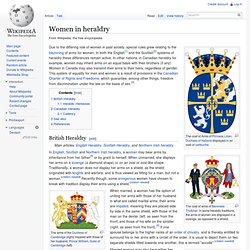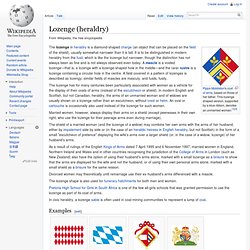

Heraldry. Heraldry. Basic Heraldry. Symbolism of Heraldry. Symbolisms of Heraldry Meanings of the symbols found in heraldry and on coats of arms.

The following symbolisms have been excerpted from W. Cecil Wade's "The Symbolisms of Heraldry or A Treatise on the Meanings and Derivations of Armorial Bearings". Published in London in 1898. Colors and Metals Or, yellow or gold - Generosity. Argent, white or silver - Peace and sincerity. Sable or black - Constancy, sometimes grief. Azure or blue - Loyalty and truth. Gules or red - Military fortitude and magnanimity. Vert or green - Hope, joy and sometimes loyalty in love. Purpure, purple - Royal majesty, sovereignty and justice. Tenne or tawney - Worthy ambition. Murray or sanguine - Not hasty in battle, and yet a victor. Heraldic Lines Nebulee or Nebuly - The sea or water. Engrailed and Invected - Earth or land. Indented - Fire. Dancette - Water. Ragulee or Raguly - Difficulties which have been encountered.
Embattled - Fire or the walls of a fortress or town. Ordinaries Chief - Dominion and authority. Gyron - Unity. Women in heraldry. Due to the differing role of women in past society, special rules grew relating to the blazoning of arms for women.

In both the English[1] and the Scottish[2] systems of heraldry these differences remain active. In other nations, in Canadian heraldry for example, women may inherit arms on an equal basis with their brothers (if any). Women in Canada may also transmit their arms to their heirs, regardless of gender. This system of equality for men and women is a result of provisions in the Canadian Charter of Rights and Freedoms, which guarantee, among other things, freedom from discrimination under the law on the basis of sex.[3] British Heraldry[edit] The coat of arms of Baroness Thatcher: in some heraldic traditions, the arms of women are displayed in a lozenge, as opposed to a shield. In English, Scottish and Northern Irish heraldry, a woman may bear arms by inheritance from her father[4] or by grant to herself. Heraldic Heiresses[edit]
Lozenge (heraldry) Married women, however, always display their arms on a shield (except peeresses in their own right, who use the lozenge for their peerage arms even during marriage).

As a result of rulings of the English Kings of Arms dated 7 April 1995 and 6 November 1997, married women in England, Northern Ireland and Wales and in other countries recognising the jurisdiction of the College of Arms in London (such as New Zealand) also have the option of using their husband's arms alone, marked with a small lozenge as a brisure to show that the arms are displayed for the wife and not the husband, or of using their own personal arms alone, marked with a small shield as a brisure for the same reason.
Divorced women may theoretically until remarriage use their ex-husband's arms differenced with a mascle. The lozenge shape is also used for funerary hatchments for both men and women. Arms of Borredà, a municipality in Catalonia Fox-Davies, Arthur Charles (1909). Cadency. Systems[edit] Systematic cadency schemes were later developed in England and Scotland, but while in England they are voluntary (and not always observed), in Scotland they are enforced through the statutorily required process of matriculation in the Public Register.

England[edit] The arms of the Earl Russell. The mullet sable (black star) upon the central escallop differentiates it from the arms of the Duke of Bedford. The English system of cadency involves the addition of these brisures to the plain coat: In England, arms are generally the property of their owner from birth - subject to the use of the appropriate mark of cadency.
At times arms with a cadency mark may be used on a hereditary basis: for instance, the arms of the Earls Russell are those of the Duke of Bedford differenced by a mullet, as the 1st Earl was the third son of the 6th Duke. Nor have cadency marks usually been insisted upon by the College of Arms (the heraldic authority for England, Wales and formerly Ireland).